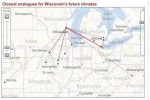 In June 2012, Diana Hammer Tscheschlok attended an in-service with UW-Extension colleagues to learn the latest climate science and energy conservation strategies. As a result of this workshop, she is infusing more climate science into her work in Fond du Lac County. While climate change is a global phenomenon, there are many impactful ways to respond locally. Here are the most important points about climate science from the training:
In June 2012, Diana Hammer Tscheschlok attended an in-service with UW-Extension colleagues to learn the latest climate science and energy conservation strategies. As a result of this workshop, she is infusing more climate science into her work in Fond du Lac County. While climate change is a global phenomenon, there are many impactful ways to respond locally. Here are the most important points about climate science from the training:
- WI gets 80% of our fuel (fossil) from outside the state which takes $13 billion per year ($2800 per person) out of our local economy.
- Scientists agree that burning fossil fuels and land clearing (trees into crops) creates carbon emissions which raise the temperature of the earth.
- The US military is a leader in climate change research and adaptation. “[It] is a threat multiplier. Climate instability will lead to instability in geopolitics and impact American military operations around the world.” Army Chief of Staff & General Tony Zinni, Quadrennial Review (2010).
- Actual emissions on earth have been matching the worst case scenario prediction for the past 20 years, and the amount of fossil fuel we burn continues to increase.
- Many scientists believe our best chance of minimizing the negative impacts of global warming (rising sea levels, etc.) is to slow warming to only 2 degrees warmer by 2100. To do this, the total amount of carbon emissions needs to peak in 2017 or sooner.
- On a graph, the shape of emissions dropping looks like a wedge. Each wedge is worth 25 Gigatons of carbon over 50 years or 2500 Gigawatts of electricity. To have a 50% chance of limiting temperature increases to 2 degrees, we need to have 14 wedges in place.
- The U.S. could achieve 110 wedges if all available options were used (reducing miles traveled by car, increasing fuel efficiency of cars, lower use of electricity from fossil fuels, solar arrays, off-shore wind, etc.) .
- “Delaying action is a false economy: for every $1 of investment in cleaner technology that is avoided in the power sector before 2020, an additional $4.30 would need to be spent after 2020 to compensate for the increased emissions.” International Energy Agency 2011 Energy Outlook
This in-service was hosted by the State Energy Extension Partnership, an effort funded by a US Department of Energy grant to WI. Learn more at http://energyonwi.uwex.edu/.
To view a short video on climate change impacts in WI, visit the WI Initiative on Climate Change.




